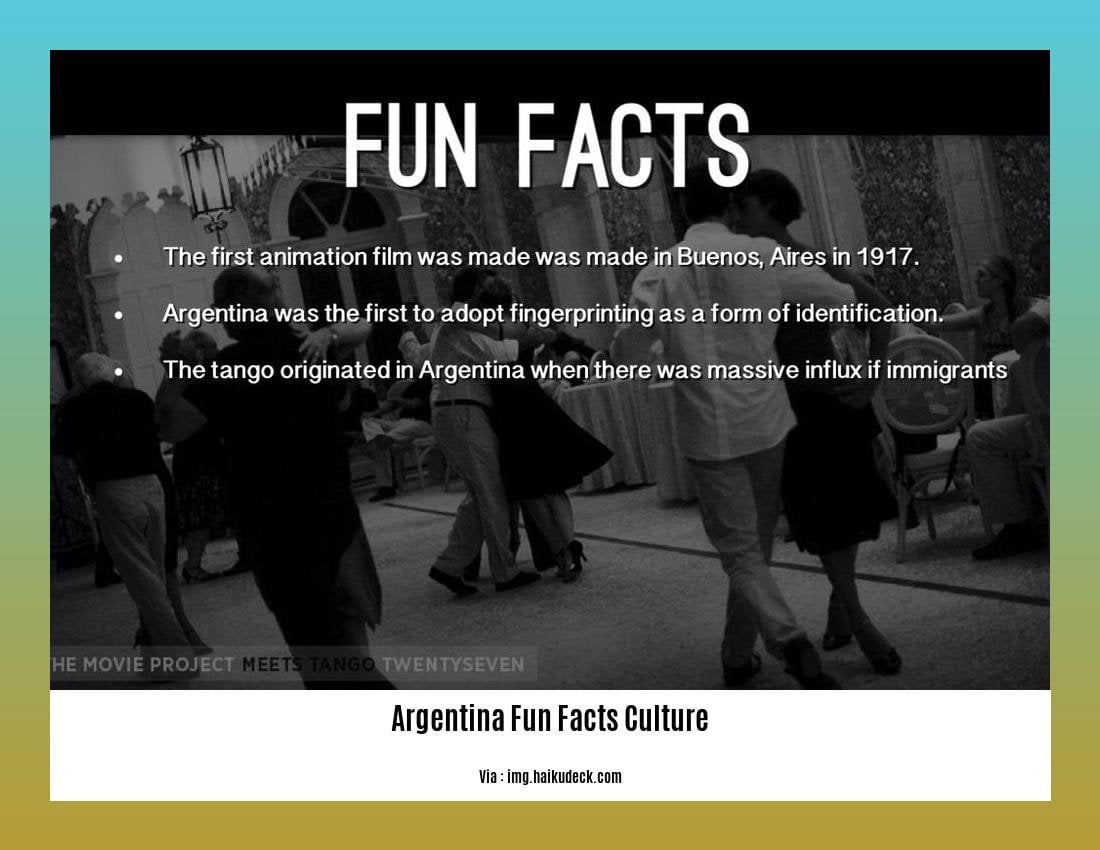Uncovering Argentina: Exploring Fun Facts and Cultural Gems takes you on a captivating journey through the vibrant and diverse culture of Argentina. From the enchanting streets of Buenos Aires to the breathtaking landscapes of Patagonia, this article delves into the lesser-known fun facts and hidden gems that make Argentina a truly remarkable destination. Get ready to be immersed in the rich heritage, mesmerizing beauty, and lively festivities of Tango as we uncover the fascinating cultural nuances that make Argentina a must-visit location for any traveler.
Key Takeaways:
– Argentina is the birthplace of tango, a popular music and dance style.
– Argentina was the first Latin American country to have a pope, Pope Francis.
– Argentina has the largest Jewish and Muslim populations in Latin America, with a significant Jewish population globally.
– The gaucho, symbolizing Argentinean culture, is a traditional cowboy or horseman.
– Che Guevara, a revolutionary leader and icon, was born in Argentina.
– Argentina’s name originates from the Latin word for silver, argentum.
– Argentina was the first country in Latin America to legalize same-sex marriage.
– Argentina is home to some of the highest mountains in the world, including Aconcagua.
– Argentina was the first country to use fingerprints to solve crimes in 1892.
Argentina Fun Facts and Cultural Gems

Argentina is a land of captivating culture and intriguing history, filled with fascinating fun facts that will leave you in awe. From the mesmerizing music and dance of tango to the rich diversity of its population, this vibrant nation holds endless wonders to explore. So grab your virtual passport as we delve into some of the most intriguing fun facts and cultural gems of Argentina!
Tango: The Heartbeat of Argentina
When it comes to fun facts about Argentina, tango takes center stage. Originating in the vibrant streets of Buenos Aires in the late 19th century, tango symbolizes the passion and soul of the Argentine people. Its rhythmic melodies and enchanting dance moves have captured the hearts of millions worldwide. So put on your dancing shoes and immerse yourself in the seductive embrace of the tango.
Pope Francis: Argentina’s Spiritual Ambassador
Did you know that Argentina gave the world its first Latin American pope? Pope Francis, born Jorge Mario Bergoglio in Buenos Aires, brings a touch of Argentine pride to the Vatican. His humble nature and emphasis on social justice reflect the values deeply rooted in Argentine culture. Join us on a journey to discover the spiritual heritage that flows through the streets of Buenos Aires.
Diverse Populations: A Tapestry of Cultures
Argentina boasts the largest Jewish and Muslim populations in Latin America, with its Jewish community ranking among the top seven worldwide. This ethnic mosaic adds a special flavor to the Argentine cultural landscape. Explore the synagogues and mosques that dot the cities, and witness the harmonious coexistence of different religious traditions.
Gauchos: The Cowboys of the Pampas
In Argentina, the gaucho stands tall as a cultural emblem. These skilled horsemen and cowboys have roamed the endless plains of the country for centuries. Their colorful attire, impressive horsemanship, and unique way of life paint a vivid picture of Argentina’s rural heritage. Get ready to saddle up and join the gauchos on a journey through their rich traditions and customs.
Che Guevara: Revolutionary Icon
Born in Argentina, Ernesto “Che” Guevara left an indelible mark on the world as a revolutionary leader and cultural icon. His fight for social justice resonates deeply with the Argentine spirit. Explore the places where Che Guevara lived and left his revolutionary legacy, embracing the powerful symbolism that continues to inspire generations.
Silver Legacy: The Origin of Argentina’s Name
Argentina takes its name from the Latin word “argentum,” meaning silver. This name reflects the belief in abundant silver deposits within the country. While the silver may not be as abundant as once thought, the charm and beauty of Argentina remain as valuable as ever. Embark on a journey to unravel the country’s rich history and discover the hidden treasures that lie within.
Same-Sex Marriage: A Trailblazing Nation
In 2010, Argentina made history by becoming the first country in Latin America to legalize same-sex marriage. This progressive step reflected the nation’s commitment to equality and human rights. Join us as we explore the vibrant LGBTQ+ community in Argentina, witnessing the celebrations of love and acceptance that adorn its streets.
Majestic Mountains: A Paradise for the Adventurous
Argentina is home to some of the highest mountains in the world, including the mighty Aconcagua, the tallest peak in the Western Hemisphere. These majestic mountains provide a playground for outdoor enthusiasts and awe-inspiring landscapes for nature lovers. Lace up your hiking boots and embark on a thrilling adventure, basking in the breathtaking beauty of Argentina’s mountainous wonders.
Fingerprint Forensics: Argentina’s Crime-Solving Pioneers
Long before fingerprint analysis became a common investigative tool, Argentina pioneered its use in solving crimes. In 1892, the country became the first in the world to utilize fingerprints for forensic purposes, revolutionizing the field of crime investigation. Explore the fascinating world of forensic science in Argentina, unraveling the stories hidden within the ridges of our fingertips.
Argentina weaves a tapestry of culture, history, and excitement that leaves an indelible mark on all who explore its wonders. From the passionate rhythm of tango to the charming traditions of the gauchos, this captivating nation offers a truly unforgettable experience. So come, discover Argentina’s fun facts and cultural gems, and let its vibrant spirit ignite your sense of adventure.
Here are some fascinating facts about Argentina, perfect for those who are looking to learn more about this exciting country:
-
Argentina fun facts: Discover interesting tidbits about Argentina by clicking here.
-
If you want to delve into Argentina’s culture and language, explore our collection of Argentina fun facts in Spanish here.
Now, let’s journey to the mesmerizing Arizona desert and uncover its unique features:
-
Uncover the hidden wonders of the Arizona desert with these intriguing desert facts by clicking here.
-
Are you curious to know more about the captivating Arizona desert region? Explore fascinating facts about this distinctive area here.
Discover the beauty and allure of Argentina and the Arizona desert through these captivating links!
Fascinating facts about Argentinean cuisine
Argentina, a country known for its vibrant culture and captivating landscapes, is also home to a cuisine that is as diverse and enticing as its heritage. From succulent cuts of beef to traditional South American drinks, Argentinean cuisine offers a feast for both the palate and the soul. Let’s uncover some fascinating facts about the flavors that define this enchanting country.
The Argentinean Asado: A Meat Lover’s Paradise
When it comes to meat, Argentinians take their love for it to another level. In fact, Argentina consumes more beef per capita than any other country in the world. The country’s famous asado, a traditional barbecue, is a celebration of different cuts of beef cooked to perfection. From juicy ribs to tender sirloin, flavorful skirt steak to mouthwatering tenderloin, the asado boasts a variety of meaty delights. But it doesn’t stop there. Sausages like chorizo and blood sausage, succulent chicken breasts, and even sweetbreads make their way onto the grill, adding even more depth to this culinary extravaganza.
A Blend of Cultures: Influences on Argentinean Cuisine
Argentinean cuisine is a melting pot of flavors, embodying influences from indigenous cultures as well as European nations like France, Italy, and Spain. This rich blend of culinary traditions has given rise to dishes that are both unique and delicious. From heavenly desserts like dulce de leche, alfajores, and chocotorta to refreshing drinks like mate, a traditional South American infused beverage, and malbec wine, Argentinean cuisine is a true reflection of the country’s diverse cultural tapestry.
Chimichurri: The Flavorful Condiment
No article about Argentinean cuisine would be complete without mentioning chimichurri. This bright green sauce is a staple condiment in Argentina and is loved for its vibrant flavors. Made with a base of parsley, garlic, vinegar, and spices, chimichurri is typically served alongside grilled meats, adding a burst of freshness and tanginess to every bite. Its herbaceous aroma and zesty taste make it a must-try for any food enthusiast exploring Argentinean cuisine.
Salud! The Argentinean Toast
When it’s time for a celebratory toast in Argentina, you won’t be saying “cheers,” but rather “salud!” This Spanish word, meaning “health,” is the traditional way to raise a glass and toast in Argentina. So, the next time you find yourself surrounded by friends and good company in this vibrant country, remember to say “salud!”
Key Takeaways:
- Argentina consumes more beef per capita than any other country in the world, making it a haven for meat lovers.
- Argentinean cuisine is a fusion of indigenous and European flavors, creating a unique culinary experience.
- The traditional chimichurri sauce adds a burst of fresh and tangy flavors to grilled meats.
- In Argentina, the word for “cheers” is “salud,” reflecting the country’s rich cultural heritage.
Sources:
– Travel Trivia Challenge. Link Here.
– Kidadl. Link Here.
Celebrating Tango: The Iconic Dance of Argentina

Argentina is a country celebrated for its vibrant culture, rich history, and diverse traditions. One of the most famous cultural gems that truly embodies the spirit of Argentina is the iconic dance known as tango. This sensual and passionate dance has captivated the hearts of people around the world, and in this article, we will explore some intriguing facts and fascinating insights about the tango.
Tango Salons and Traditions: Milongas and Changing Times
When it comes to tango, you may have heard of the term “milongas.” These are the traditional tango salons where the dance is performed and enjoyed. However, over time, the traditions of tango have evolved, and nowadays, you can find tango being danced in many different milongas. This shows the changing nature of the dance, as it continues to adapt and embrace new influences.
The Origins and Meaning of Tango
Did you know that the word “tango” itself has African roots? It is believed to have originated from African slaves, with “tango” meaning “drum” in some African languages. This fascinating connection highlights the cultural fusion that gave birth to tango, blending African rhythms with European influences.
The Birth of Tango: Music and Dance in Harmony
Tango is not just a dance; it is also a music genre. Initially, tango was a dance that was completely improvised, with its roots in the working-class neighborhoods of Buenos Aires and Montevideo. This music and dance style emerged as an expression of the unprivileged, fueled by a mix of European immigrants, influences from African slaves, and dances and music styles from native settlers.
Tango and High Society
Over time, tango began to transcend its humble origins and captured the attention of high society. It was embraced by the affluent and accepted into the glamorous ballrooms of the upper class, thanks to the French influence. Tango became a symbol of elegance and sophistication, while still retaining its heartfelt, passionate essence.
A Diverse Tango: Various Styles and Rich History
Argentine tango is a dance with a rich history and various styles. From the traditional Argentine tango to the sensual Argentine vals and the playful milonga, each style has its own unique characteristics and rhythms. Exploring the different styles and their evolution over time is like embarking on a journey through the history of Argentina itself.
A Rhythmic Heartbeat: Tango and Cultural Heritage
Tango holds a special place in the heart of Argentina and is considered the rhythmic heartbeat of the nation. In recognition of its cultural significance, tango was added to UNESCO’s list of intangible cultural heritage in 2009. This honor showcases the deep-rooted connection between tango and the Argentine identity.
Key Takeaways:
- Tango salons in Argentina are known as milongas, and the traditions of tango are evolving.
- The word “tango” originated from African languages, with its meaning being “drum.”
- Tango emerged as a music and dance form that was first improvised in the working-class neighborhoods of Buenos Aires and Montevideo.
- Thanks to French influence, tango was accepted into high society and became a symbol of elegance.
- Argentine tango has a rich history and encompasses various styles, including the traditional tango, Argentine vals, and milonga.
- Tango is considered the rhythmic heartbeat of Argentina and holds a significant place in the country’s cultural heritage.
Sources:
– Insight Vacations Tango Argentina Dance
– Dance Facts – Argentine Tango
Hidden gems: Exploring off-the-beaten-path destinations in Argentina
Argentina, with its vibrant culture and captivating landscapes, offers a plethora of hidden gems that are waiting to be discovered. These off-the-beaten-path destinations provide a refreshing alternative to traditional travel experiences, offering authenticity, tranquility, and unique adventures. In this article, we will uncover some of the lesser-known fun facts and cultural gems that make Argentina a truly remarkable destination.
Off-the-beaten-path destinations in Argentina
Argentina is home to a diverse range of off-the-beaten-path destinations that promise unforgettable experiences. From enchanted forests to secluded mountain villages, here are some hidden gems worth exploring:
-
El Chaltén: Nestled in the heart of the Patagonian Andes, El Chaltén is a hiker’s paradise. With its snow-capped peaks, glittering lakes, and mesmerizing glaciers, this picturesque town offers breathtaking landscapes that will leave you in awe.
-
Purmamarca: Located in the Jujuy province, Purmamarca is a charming village renowned for its stunning landscapes and vibrant culture. The nearby Cerro de los Siete Colores (Hill of Seven Colors) is a natural wonder that will leave you speechless.
-
Colonia Carlos Pellegrini: Situated in the heart of the Esteros del Iberá wetlands, Colonia Carlos Pellegrini is a hidden gem for nature lovers. Explore the rich biodiversity of this unique ecosystem, spot wildlife species like capybaras and caimans, and immerse yourself in the tranquility of the marshlands.
-
Villa Epecuén: Once a thriving tourist destination, Villa Epecuén was submersed in water for over 25 years. Today, the ghost town has emerged from the depths, creating an eerie yet fascinating sight for curious travelers.
-
Cafayate: Nestled in the midst of Argentina’s renowned wine region, Cafayate offers a charming blend of vineyards, majestic landscapes, and colonial architecture. Sample exquisite wines, admire the red rock formations of Quebrada de las Conchas, and soak in the laid-back atmosphere of this hidden gem.
Uncovering Argentina’s fun facts and cultural gems
Argentina is a country rich in history, culture, and fascinating traditions. Let’s delve into some fun facts and cultural gems that make Argentina truly unique:
1. Mate: The National Infusion
Argentines have a deep affection for mate, a traditional South American infused drink. Sharing mate with friends and family is not only a social ritual but also a symbol of friendship and camaraderie. Experience the warmth and camaraderie of this beloved tradition as you indulge in the strong yet invigorating flavors of mate.
2. Asado: The Art of Barbecue
Argentinians are masters of the grill, and their love for barbecue, known as “asado,” runs deep. Here, the sizzling aroma of succulent beef cuts fills the air, tantalizing taste buds and igniting a deep appreciation for the art of grilling. From ribs to sirloin, each cut is carefully prepared and cooked to perfection, creating a culinary delight that you won’t soon forget.
3. Tango: The Soul of Argentina
No exploration of Argentina is complete without a taste of its vibrant tango culture. From the dimly lit milongas (tango salons) to the passionate dance moves, tango embodies the essence of Argentina’s soul. Discover the sultry rhythms, the intimate connections, and the timeless allure of this mesmerizing dance form that has come to symbolize the passion and spirit of the Argentine people.
4. Hidden Cultural Treasures
Argentina’s cultural tapestry is woven with diverse influences, including the largest Jewish and Muslim communities in Latin America. Explore the neighborhoods of Once and Palermo in Buenos Aires to witness the vibrant Jewish culture, or visit the ornate mosques in Tigre to immerse yourself in the rich traditions of the Muslim community. These hidden cultural treasures highlight the country’s commitment to diversity and showcase the melting pot of cultures that coexist harmoniously in Argentina.
5. Extravagant Architecture
Argentina boasts a captivating blend of architectural styles that reflect its historical and cultural heritage. From the ornate French-inspired buildings of Buenos Aires to the colorful colonial facades of Salta and Cordoba, each city offers a visual feast for architecture enthusiasts. Take a stroll through the streets and marvel at the intricate details and grandeur that grace each structure, transporting you to a bygone era.
Key Takeaways:
- Argentina is home to a myriad of off-the-beaten-path destinations, including El Chaltén, Purmamarca, Colonia Carlos Pellegrini, Villa Epecuén, and Cafayate.
- Mate, the national infusion, and asado, the art of barbecue, are integral parts of Argentina’s cultural identity.
- Tango epitomizes Argentina’s passion and soul, captivating locals and visitors alike.
- Argentina’s cultural landscape is enriched by its diverse populations, including the largest Jewish and Muslim communities in Latin America.
- The country’s architectural treasures showcase a fusion of styles, from French-inspired buildings to colorful colonial facades.
Sources:
FAQ
Q1: What is the origin of tango and its significance in Argentina?
A1: Tango originated in Buenos Aires in the late 19th century and is a popular type of music and dance in Argentina. It emerged as the music of the unprivileged in working-class neighborhoods, and its traditions have changed over time. Today, tango is considered a rhythmic heartbeat of the nation and was added to UNESCO’s list of intangible cultural heritage in 2009.
Q2: What are some interesting fun facts about Argentina’s culture?
A2: Argentina has the largest Jewish and Muslim populations in Latin America, and the country’s Jewish population is the seventh largest in the world. The gaucho, symbolic of Argentinean culture, represents the cowboys or horsemen living in the plains. Additionally, the revolutionary leader and icon, Che Guevara, was born in Argentina.
Q3: Why is Argentina known for its beef?
A3: Argentinians consume more beef per capita than any other country in the world. The country is famous for its flavorful and tender beef, and traditional Argentinian barbecues, called asados, feature various cuts of beef, sausages, and other meats.
Q4: What are some traditional dishes and drinks in Argentina?
A4: Argentina’s cuisine draws influence from indigenous cultures and European nations like France, Italy, and Spain. Traditional desserts include dulce de leche, alfajores, and chocotorta. Common drinks include mate, a traditional South American infused drink, and malbec wine. Argentinian cuisine is also known for its famous green sauce called chimichurri, commonly used as a condiment for grilled meats.
Q5: What are some off-the-beaten-path destinations in Argentina worth exploring?
A5: While Argentina itself offers plenty of well-known tourist destinations, there are also off-the-beaten-path gems to explore. Some lesser-known destinations include Matera, Italy; Kotor, Montenegro; Mtskheta, Georgia; San Cristóbal de Las Casas, Mexico; Isfahan, Iran; Kampot, Cambodia; Cuenca, Ecuador; Rovinj, Croatia; and Salento, Colombia. These locations offer adventure, cultural immersion, and unforgettable experiences for travelers seeking an authentic and unique journey.
- Unveiling the Enigma: Mansoureh Khojasteh Bagherzadeh’s Public Appearances & Private Life in Iran - July 18, 2025
- Unveiling the Mystery: Mansoureh Khojasteh Bagherzadeh’s Husband: A Rare Glimpse into a Private Life - July 18, 2025
- Unveiling Masoud Khamenei’s Mother: Power, Influence, and Iran’s Future - July 18, 2025
















